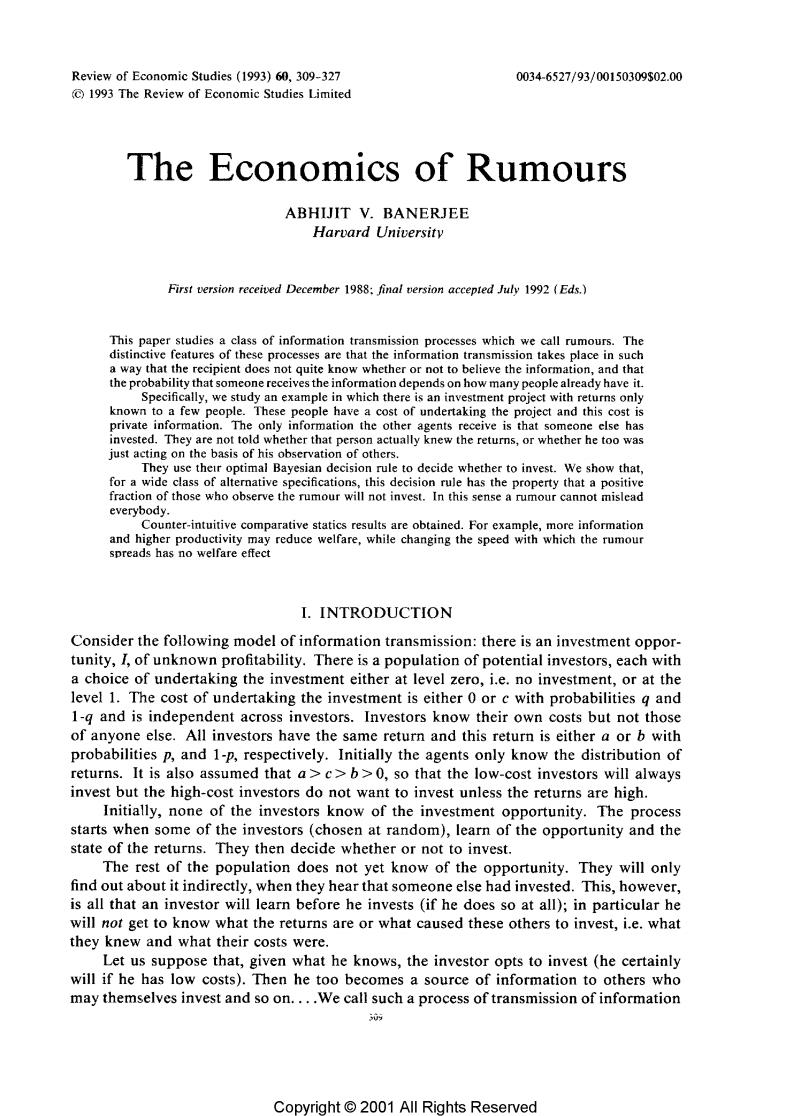
Review of Economic Studies (1993)60,309-327 0034-6527/93/00150309$02.00 C)1993 The Review of Economic Studies Limited The Economics of Rumours ABHIJIT V.BANERJEE Harvard University First version received December 1988:final version accepted July 1992(Eds.) This paper studies a class of information transmission processes which we call rumours.The distinctive features of these processes are that the information transmission takes place in such a way that the recipient does not quite know whether or not to believe the information,and that the probability that someone receives the information depends on how many people already have it. Specifically,we study an example in which there is an investment project with returns only known to a few people.These people have a cost of undertaking the project and this cost is private information.The only information the other agents receive is that someone else has invested.They are not told whether that person actually knew the returns,or whether he too was just acting on the basis of his observation of others. They use their optimal Bayesian decision rule to decide whether to invest.We show that, for a wide class of alternative specifications,this decision rule has the property that a positive fraction of those who observe the rumour will not invest.In this sense a rumour cannot mislead everybody. Counter-intuitive comparative statics results are obtained.For example,more information and higher productivity may reduce welfare,while changing the speed with which the rumour spreads has no welfare effect I.INTRODUCTION Consider the following model of information transmission:there is an investment oppor- tunity,I,of unknown profitability.There is a population of potential investors,each with a choice of undertaking the investment either at level zero,i.e.no investment,or at the level 1.The cost of undertaking the investment is either 0 or c with probabilities g and 1-g and is independent across investors.Investors know their own costs but not those of anyone else.All investors have the same return and this return is either a or b with probabilities p,and 1-p,respectively.Initially the agents only know the distribution of returns.It is also assumed that a>c>b>0,so that the low-cost investors will always invest but the high-cost investors do not want to invest unless the returns are high. Initially,none of the investors know of the investment opportunity.The process starts when some of the investors(chosen at random),learn of the opportunity and the state of the returns.They then decide whether or not to invest. The rest of the population does not yet know of the opportunity.They will only find out about it indirectly,when they hear that someone else had invested.This,however, is all that an investor will learn before he invests (if he does so at all);in particular he will not get to know what the returns are or what caused these others to invest,i.e.what they knew and what their costs were. Let us suppose that,given what he knows,the investor opts to invest (he certainly will if he has low costs).Then he too becomes a source of information to others who may themselves invest and so on....We call such a process of transmission of information 09 Copyright 2001 All Rights Reserved
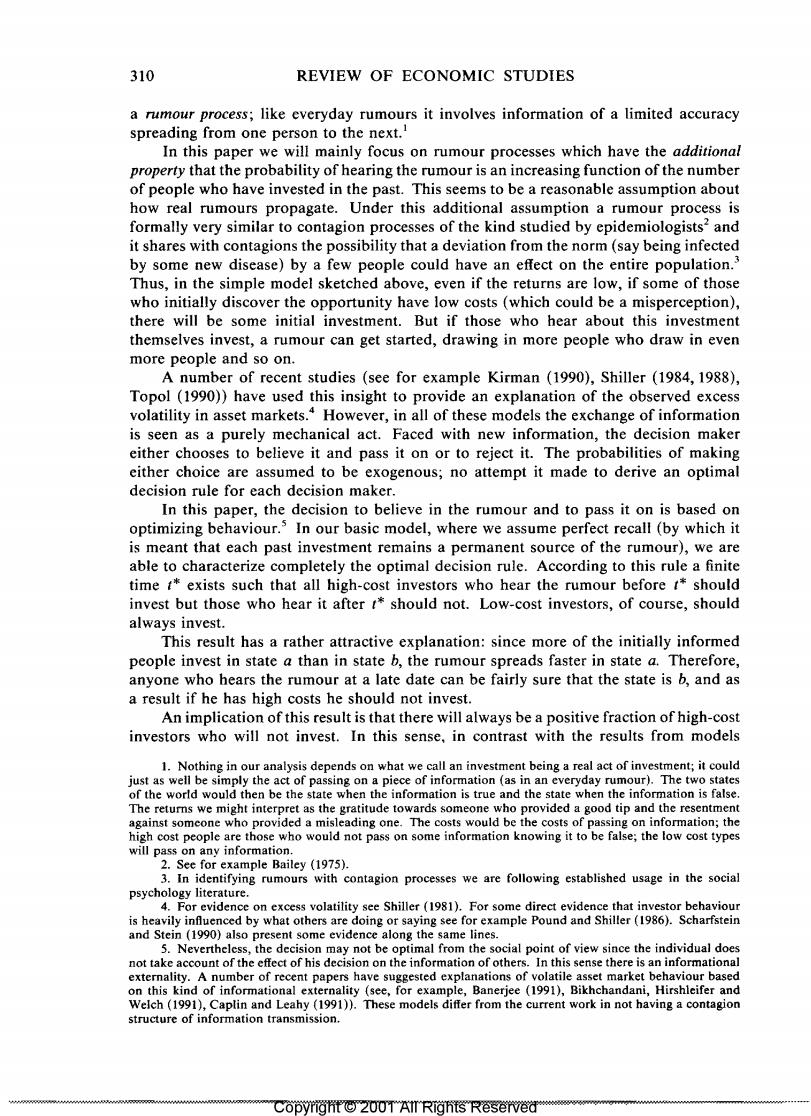
310 REVIEW OF ECONOMIC STUDIES a rumour process;like everyday rumours it involves information of a limited accuracy spreading from one person to the next. In this paper we will mainly focus on rumour processes which have the additional property that the probability of hearing the rumour is an increasing function of the number of people who have invested in the past.This seems to be a reasonable assumption about how real rumours propagate.Under this additional assumption a rumour process is formally very similar to contagion processes of the kind studied by epidemiologists'and it shares with contagions the possibility that a deviation from the norm(say being infected by some new disease)by a few people could have an effect on the entire population.3 Thus,in the simple model sketched above,even if the returns are low,if some of those who initially discover the opportunity have low costs(which could be a misperception), there will be some initial investment.But if those who hear about this investment themselves invest,a rumour can get started,drawing in more people who draw in even more people and so on. A number of recent studies (see for example Kirman (1990),Shiller (1984,1988), Topol (1990))have used this insight to provide an explanation of the observed excess volatility in asset markets.However,in all of these models the exchange of information is seen as a purely mechanical act.Faced with new information,the decision maker either chooses to believe it and pass it on or to reject it.The probabilities of making either choice are assumed to be exogenous;no attempt it made to derive an optimal decision rule for each decision maker. In this paper,the decision to believe in the rumour and to pass it on is based on optimizing behaviour.3 In our basic model,where we assume perfect recall(by which it is meant that each past investment remains a permanent source of the rumour),we are able to characterize completely the optimal decision rule.According to this rule a finite time t*exists such that all high-cost investors who hear the rumour before t*should invest but those who hear it after t*should not.Low-cost investors,of course,should always invest. This result has a rather attractive explanation:since more of the initially informed people invest in state a than in state b,the rumour spreads faster in state a.Therefore, anyone who hears the rumour at a late date can be fairly sure that the state is b,and as a result if he has high costs he should not invest. An implication of this result is that there will always be a positive fraction of high-cost investors who will not invest.In this sense,in contrast with the results from models 1.Nothing in our analysis depends on what we call an investment being a real act of investment;it could just as well be simply the act of passing on a piece of information(as in an everyday rumour).The two states of the world would then be the state when the information is true and the state when the information is false. The returns we might interpret as the gratitude towards someone who provided a good tip and the resentment against someone who provided a misleading one.The costs would be the costs of passing on information;the high cost people are those who would not pass on some information knowing it to be false;the low cost types will pass on any information. 2.See for example Bailey (1975). 3.In identifying rumours with contagion processes we are following established usage in the social psychology literature. 4.For evidence on excess volatility see Shiller (1981).For some direct evidence that investor behaviour is heavily influenced by what others are doing or saying see for example Pound and Shiller(1986).Scharfstein and Stein (1990)also present some evidence along the same lines. 5.Nevertheless,the decision may not be optimal from the social point of view since the individual does not take account of the effect of his decision on the information of others.In this sense there is an informational externality.A number of recent papers have suggested explanations of volatile asset market behaviour based on this kind of informational externality (see,for example,Banerjee (1991),Bikhchandani,Hirshleifer and Welch(1991),Caplin and Leahy (1991)).These models differ from the current work in not having a contagion structure of information transmission. C6Dyri0it©200TA1TRI心fi搭RsěrvěT
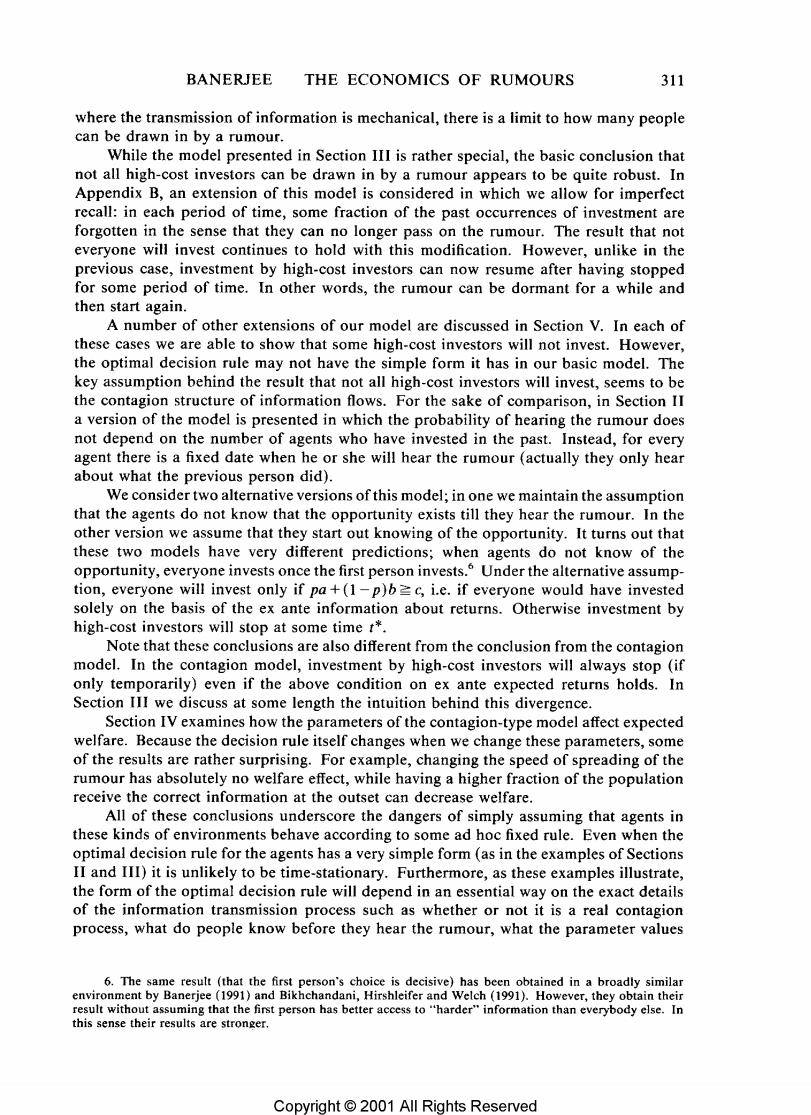
BANERJEE THE ECONOMICS OF RUMOURS 311 where the transmission of information is mechanical,there is a limit to how many people can be drawn in by a rumour. While the model presented in Section III is rather special,the basic conclusion that not all high-cost investors can be drawn in by a rumour appears to be quite robust.In Appendix B,an extension of this model is considered in which we allow for imperfect recall:in each period of time,some fraction of the past occurrences of investment are forgotten in the sense that they can no longer pass on the rumour.The result that not everyone will invest continues to hold with this modification.However,unlike in the previous case,investment by high-cost investors can now resume after having stopped for some period of time.In other words,the rumour can be dormant for a while and then start again. A number of other extensions of our model are discussed in Section V.In each of these cases we are able to show that some high-cost investors will not invest.However, the optimal decision rule may not have the simple form it has in our basic model.The key assumption behind the result that not all high-cost investors will invest,seems to be the contagion structure of information flows.For the sake of comparison,in Section II a version of the model is presented in which the probability of hearing the rumour does not depend on the number of agents who have invested in the past.Instead,for every agent there is a fixed date when he or she will hear the rumour (actually they only hear about what the previous person did). We consider two alternative versions of this model;in one we maintain the assumption that the agents do not know that the opportunity exists till they hear the rumour.In the other version we assume that they start out knowing of the opportunity.It turns out that these two models have very different predictions;when agents do not know of the opportunity,everyone invests once the first person invests.Under the alternative assump- tion,everyone will invest only if pa+(1-p)b=c,i.e.if everyone would have invested solely on the basis of the ex ante information about returns.Otherwise investment by high-cost investors will stop at some time t*. Note that these conclusions are also different from the conclusion from the contagion model.In the contagion model,investment by high-cost investors will always stop (if only temporarily)even if the above condition on ex ante expected returns holds.In Section IlI we discuss at some length the intuition behind this divergence. Section IV examines how the parameters of the contagion-type model affect expected welfare.Because the decision rule itself changes when we change these parameters,some of the results are rather surprising.For example,changing the speed of spreading of the rumour has absolutely no welfare effect,while having a higher fraction of the population receive the correct information at the outset can decrease welfare. All of these conclusions underscore the dangers of simply assuming that agents in these kinds of environments behave according to some ad hoc fixed rule.Even when the optimal decision rule for the agents has a very simple form(as in the examples of Sections II and III)it is unlikely to be time-stationary.Furthermore,as these examples illustrate, the form of the optimal decision rule will depend in an essential way on the exact details of the information transmission process such as whether or not it is a real contagion process,what do people know before they hear the rumour,what the parameter values 6.The same result (that the first person's choice is decisive)has been obtained in a broadly similar environment by Banerjee(1991)and Bikhchandani,Hirshleifer and Welch(1991).However,they obtain their result without assuming that the first person has better access to"harder"information than everybody else.In this sense their results are stronger. Copyright 2001 All Rights Reserved
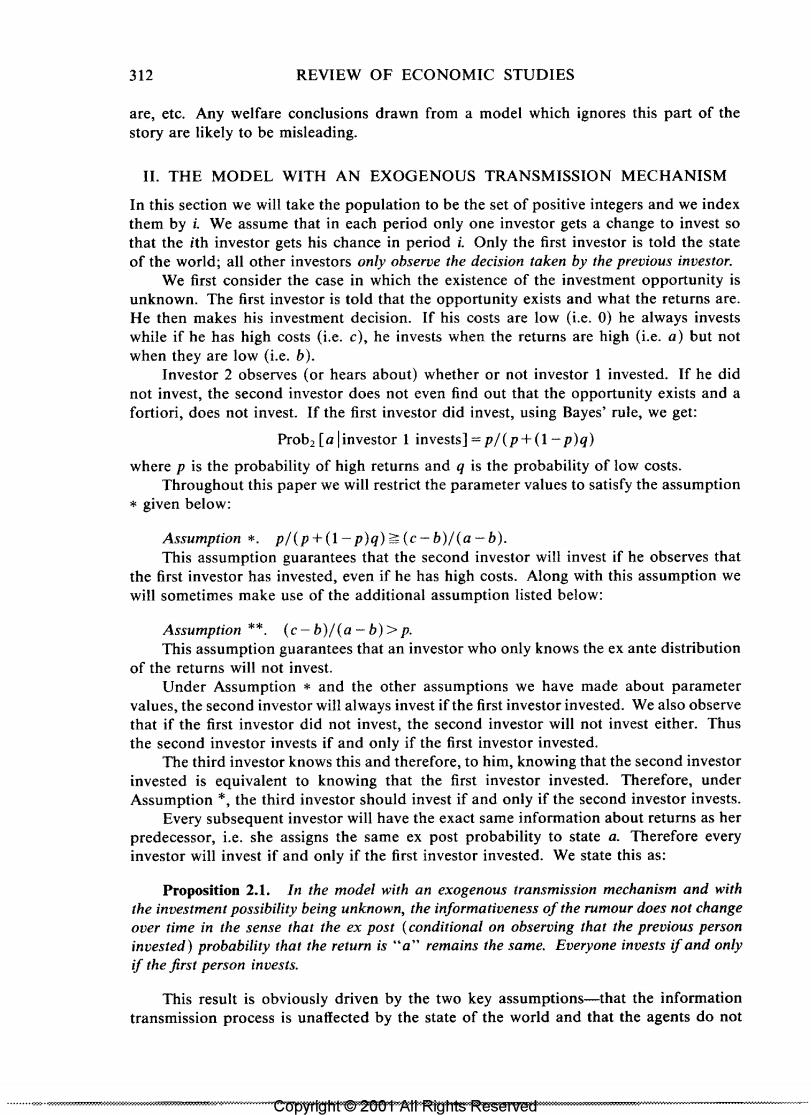
312 REVIEW OF ECONOMIC STUDIES are,etc.Any welfare conclusions drawn from a model which ignores this part of the story are likely to be misleading. II.THE MODEL WITH AN EXOGENOUS TRANSMISSION MECHANISM In this section we will take the population to be the set of positive integers and we index them by i.We assume that in each period only one investor gets a change to invest so that the ith investor gets his chance in period i.Only the first investor is told the state of the world;all other investors only observe the decision taken by the previous investor. We first consider the case in which the existence of the investment opportunity is unknown.The first investor is told that the opportunity exists and what the returns are. He then makes his investment decision.If his costs are low (i.e.0)he always invests while if he has high costs (i.e.c),he invests when the returns are high (i.e.a)but not when they are low (i.e.b). Investor 2 observes (or hears about)whether or not investor 1 invested.If he did not invest,the second investor does not even find out that the opportunity exists and a fortiori,does not invest.If the first investor did invest,using Bayes'rule,we get: Prob2 [a investor 1 invests]=p/(p+(1-p)q) where p is the probability of high returns and g is the probability of low costs. Throughout this paper we will restrict the parameter values to satisfy the assumption given below: Assumption *p/(p+(1-p)q)(c-b)/(a-b). This assumption guarantees that the second investor will invest if he observes that the first investor has invested,even if he has high costs.Along with this assumption we will sometimes make use of the additional assumption listed below: Assumption **(c-b)/(a-b)>p. This assumption guarantees that an investor who only knows the ex ante distribution of the returns will not invest. Under Assumption and the other assumptions we have made about parameter values,the second investor will always invest if the first investor invested.We also observe that if the first investor did not invest,the second investor will not invest either.Thus the second investor invests if and only if the first investor invested. The third investor knows this and therefore,to him,knowing that the second investor invested is equivalent to knowing that the first investor invested.Therefore,under Assumption *the third investor should invest if and only if the second investor invests. Every subsequent investor will have the exact same information about returns as her predecessor,i.e.she assigns the same ex post probability to state a.Therefore every investor will invest if and only if the first investor invested.We state this as: Proposition 2.1.In the model with an exogenous transmission mechanism and with the investment possibility being unknown,the informativeness of the rumour does not change over time in the sense that the ex post (conditional on observing that the previous person invested)probability that the return is "a"remains the same.Everyone invests if and only if the first person invests. This result is obviously driven by the two key assumptions-that the information transmission process is unaffected by the state of the world and that the agents do not C0 ovriant©200t*t'i帕t竹ts Reserve
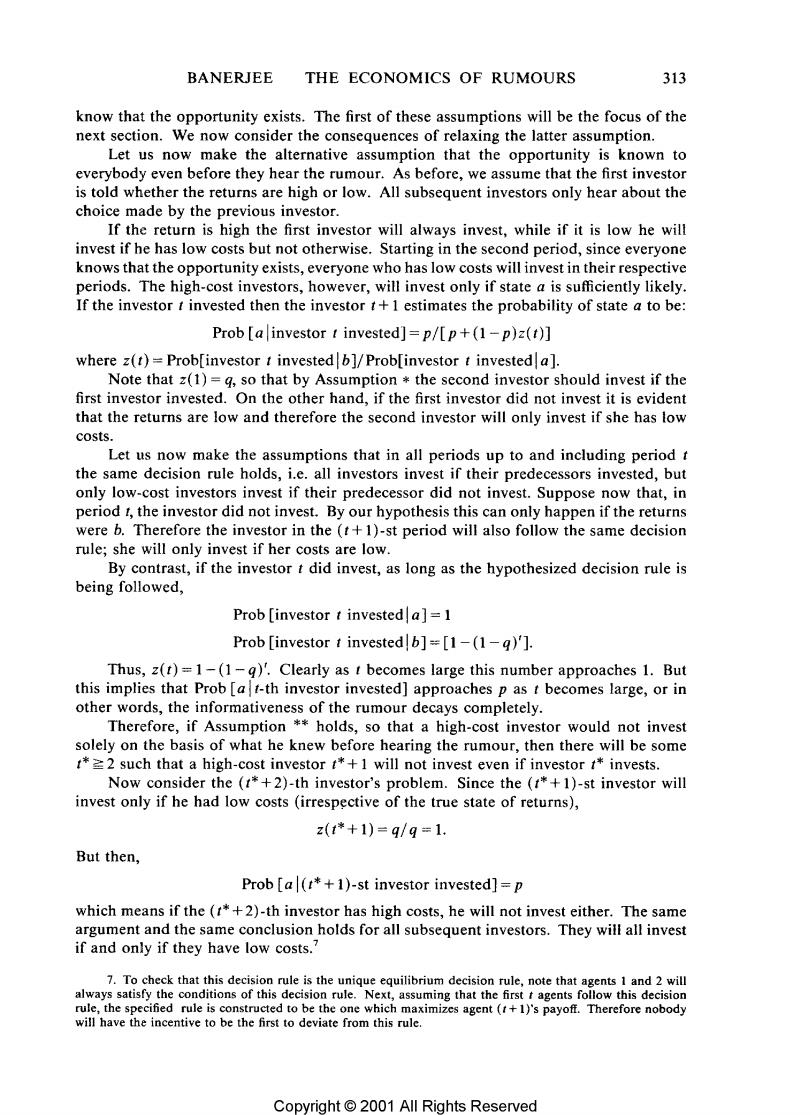
BANERJEE THE ECONOMICS OF RUMOURS 313 know that the opportunity exists.The first of these assumptions will be the focus of the next section.We now consider the consequences of relaxing the latter assumption. Let us now make the alternative assumption that the opportunity is known to everybody even before they hear the rumour.As before,we assume that the first investor is told whether the returns are high or low.All subsequent investors only hear about the choice made by the previous investor. If the return is high the first investor will always invest,while if it is low he will invest if he has low costs but not otherwise.Starting in the second period,since everyone knows that the opportunity exists,everyone who has low costs will invest in their respective periods.The high-cost investors,however,will invest only if state a is sufficiently likely. If the investor t invested then the investor t+1 estimates the probability of state a to be: Prob [a investor t invested]=p/[p+(1-p)z(t)] where z(t)=Prob[investor t invested b]/Prob[investor t invested a]. Note that z(1)=g,so that by Assumption the second investor should invest if the first investor invested.On the other hand,if the first investor did not invest it is evident that the returns are low and therefore the second investor will only invest if she has low costs. Let us now make the assumptions that in all periods up to and including period t the same decision rule holds,i.e.all investors invest if their predecessors invested,but only low-cost investors invest if their predecessor did not invest.Suppose now that,in period t,the investor did not invest.By our hypothesis this can only happen if the returns were b.Therefore the investor in the (t+1)-st period will also follow the same decision rule;she will only invest if her costs are low. By contrast,if the investor t did invest,as long as the hypothesized decision rule is being followed, Prob [investor t invested a]=1 Prob [investor t invested!b]=[1-(1-q)']. Thus,z(t)=1-(1-g).Clearly as t becomes large this number approaches 1.But this implies that Prob [at-th investor invested]approaches p as t becomes large,or in other words,the informativeness of the rumour decays completely. Therefore,if Assumption *holds,so that a high-cost investor would not invest solely on the basis of what he knew before hearing the rumour,then there will be some t*2 such that a high-cost investor t*+1 will not invest even if investor t*invests. Now consider the (t*+2)-th investor's problem.Since the (1*+1)-st investor will invest only if he had low costs (irrespective of the true state of returns), z(t*+1)=9/9=1. But then, Prob [a(t*+1)-st investor invested]=p which means if the(t*+2)-th investor has high costs,he will not invest either.The same argument and the same conclusion holds for all subsequent investors.They will all invest if and only if they have low costs.' 7.To check that this decision rule is the unique equilibrium decision rule,note that agents 1 and 2 will always satisfy the conditions of this decision rule.Next,assuming that the first t agents follow this decision rule,the specified rule is constructed to be the one which maximizes agent (t+1)'s payoff.Therefore nobody will have the incentive to be the first to deviate from this rule. Copyright 2001 All Rights Reserved
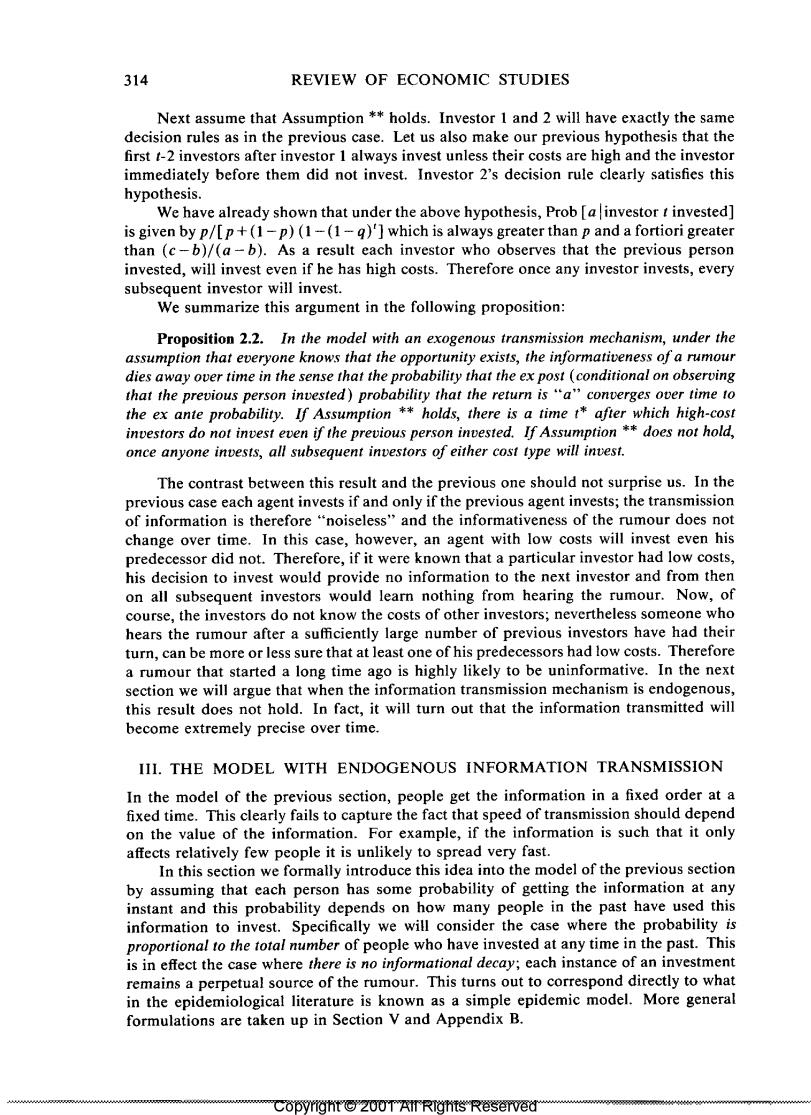
314 REVIEW OF ECONOMIC STUDIES Next assume that Assumption**holds.Investor 1 and 2 will have exactly the same decision rules as in the previous case.Let us also make our previous hypothesis that the first t-2 investors after investor 1 always invest unless their costs are high and the investor immediately before them did not invest.Investor 2's decision rule clearly satisfies this hypothesis. We have already shown that under the above hypothesis,Prob [ainvestor t invested] is given by p/[p+(1-p)(1-(1-q)]which is always greater than p and a fortiori greater than (c-b)/(a-b).As a result each investor who observes that the previous person invested,will invest even if he has high costs.Therefore once any investor invests,every subsequent investor will invest. We summarize this argument in the following proposition: Proposition 2.2.In the model with an exogenous transmission mechanism,under the assumption that everyone knows that the opportunity exists,the informativeness of a rumour dies away over time in the sense that the probability that the ex post (conditional on observing that the previous person invested)probability that the return is"a"converges over time to the ex ante probability.If Assumption *holds,there is a time t*after which high-cost investors do not invest even if the previous person invested.If Assumption *does not hold, once anyone invests,all subsequent investors of either cost type will invest. The contrast between this result and the previous one should not surprise us.In the previous case each agent invests if and only if the previous agent invests;the transmission of information is therefore "noiseless"and the informativeness of the rumour does not change over time.In this case,however,an agent with low costs will invest even his predecessor did not.Therefore,if it were known that a particular investor had low costs, his decision to invest would provide no information to the next investor and from then on all subsequent investors would learn nothing from hearing the rumour.Now,of course,the investors do not know the costs of other investors;nevertheless someone who hears the rumour after a sufficiently large number of previous investors have had their turn,can be more or less sure that at least one of his predecessors had low costs.Therefore a rumour that started a long time ago is highly likely to be uninformative.In the next section we will argue that when the information transmission mechanism is endogenous, this result does not hold.In fact,it will turn out that the information transmitted will become extremely precise over time. III.THE MODEL WITH ENDOGENOUS INFORMATION TRANSMISSION In the model of the previous section,people get the information in a fixed order at a fixed time.This clearly fails to capture the fact that speed of transmission should depend on the value of the information.For example,if the information is such that it only affects relatively few people it is unlikely to spread very fast. In this section we formally introduce this idea into the model of the previous section by assuming that each person has some probability of getting the information at any instant and this probability depends on how many people in the past have used this information to invest.Specifically we will consider the case where the probability is proportional to the total number of people who have invested at any time in the past.This is in effect the case where there is no informational decay;each instance of an investment remains a perpetual source of the rumour.This turns out to correspond directly to what in the epidemiological literature is known as a simple epidemic model.More general formulations are taken up in Section V and Appendix B. BAAAAAAA333833AA00000 Copyrignt o 200T All RIgnts Reserved
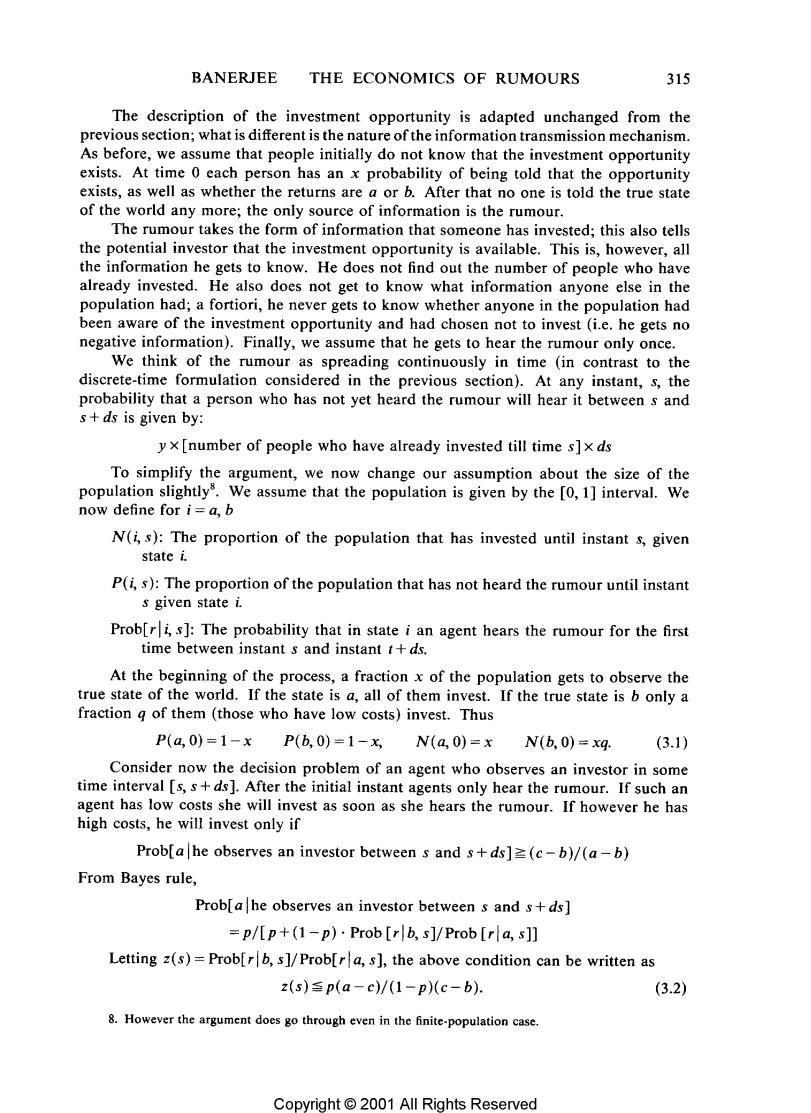
BANERJEE THE ECONOMICS OF RUMOURS 315 The description of the investment opportunity is adapted unchanged from the previous section;what is different is the nature of the information transmission mechanism. As before,we assume that people initially do not know that the investment opportunity exists.At time 0 each person has an x probability of being told that the opportunity exists,as well as whether the returns are a or b.After that no one is told the true state of the world any more;the only source of information is the rumour. The rumour takes the form of information that someone has invested;this also tells the potential investor that the investment opportunity is available.This is,however,all the information he gets to know.He does not find out the number of people who have already invested.He also does not get to know what information anyone else in the population had;a fortiori,he never gets to know whether anyone in the population had been aware of the investment opportunity and had chosen not to invest(i.e.he gets no negative information).Finally,we assume that he gets to hear the rumour only once. We think of the rumour as spreading continuously in time (in contrast to the discrete-time formulation considered in the previous section).At any instant,s,the probability that a person who has not yet heard the rumour will hear it between s and s+ds is given by: yx[number of people who have already invested till time s]x ds To simplify the argument,we now change our assumption about the size of the population slightly We assume that the population is given by the [0,1]interval.We now define for i=a,b N(i,s):The proportion of the population that has invested until instant s,given state i. P(i,s):The proportion of the population that has not heard the rumour until instant s given state i. Prob[ri,s]:The probability that in state i an agent hears the rumour for the first time between instant s and instant t+ds. At the beginning of the process,a fraction x of the population gets to observe the true state of the world.If the state is a,all of them invest.If the true state is b only a fraction g of them (those who have low costs)invest.Thus P(a,0)=1-xP(b,0)=1-x,N(a,0)=xN(b,0)=xg (3.1) Consider now the decision problem of an agent who observes an investor in some time interval [s,s+ds].After the initial instant agents only hear the rumour.If such an agent has low costs she will invest as soon as she hears the rumour.If however he has high costs,he will invest only if Prob[a he observes an investor between s and s+ds]=(c-b)/(a-b) From Bayes rule, Prob[ahe observes an investor between s and s+ds] p/[p+(1-p).Prob[r|b,s]/Prob [r a,s]] Letting z(s)=Prob[r b,s]/Prob[ra,s],the above condition can be written as z(s)=p(a-c)/(1-p)(c-b). (3.2) 8.However the argument does go through even in the finite-population case. Copyright 2001 All Rights Reserved
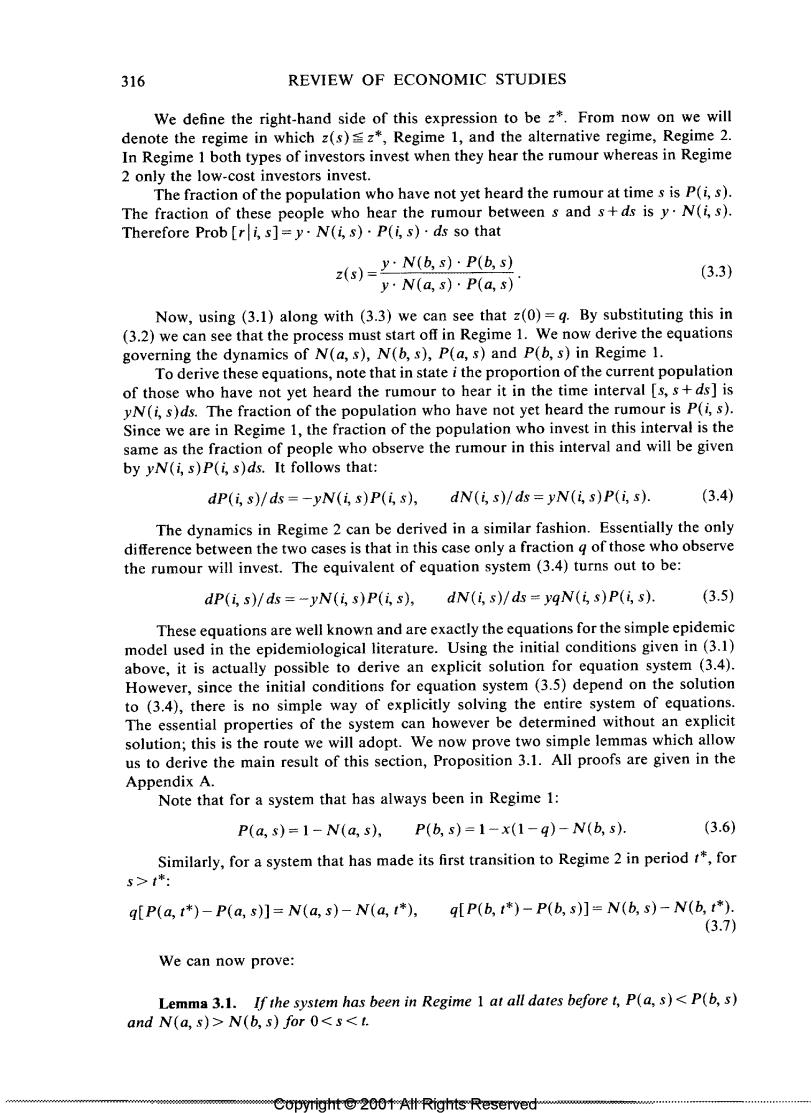
316 REVIEW OF ECONOMIC STUDIES We define the right-hand side of this expression to be z*.From now on we will denote the regime in which z(s)z*,Regime 1,and the alternative regime,Regime 2. In Regime 1 both types of investors invest when they hear the rumour whereas in Regime 2 only the low-cost investors invest. The fraction of the population who have not yet heard the rumour at time s is P(i,s). The fraction of these people who hear the rumour between s and s+ds is y.N(i,s). Therefore Prob[rli,s]=y·N(i,s)·P(i,s)·ds so that zs)=yN6·P(色s (3.3) y·N(a,s)·P(a,s) Now,using (3.1)along with (3.3)we can see that z(0)=q.By substituting this in (3.2)we can see that the process must start off in Regime 1.We now derive the equations governing the dynamics of N(a,s),N(b,s),P(a,s)and P(b,s)in Regime 1. To derive these equations,note that in state i the proportion of the current population of those who have not yet heard the rumour to hear it in the time interval [s,s+ds]is yN(i,s)ds.The fraction of the population who have not yet heard the rumour is P(i,s). Since we are in Regime 1,the fraction of the population who invest in this interval is the same as the fraction of people who observe the rumour in this interval and will be given by yN(i,s)P(i,s)ds.It follows that: dp(i,s)/ds=-yN(i,s)P(i,s),dN(i,s)/ds =yN(i,s)P(i,s). (3.4) The dynamics in Regime 2 can be derived in a similar fashion.Essentially the only difference between the two cases is that in this case only a fraction g of those who observe the rumour will invest.The equivalent of equation system(3.4)turns out to be: dp(i,s)/ds=-yN(i,s)P(i,s),dN(i,s)/ds =yqN(i,s)P(i,s). (3.5) These equations are well known and are exactly the equations for the simple epidemic model used in the epidemiological literature.Using the initial conditions given in (3.1) above,it is actually possible to derive an explicit solution for equation system (3.4). However,since the initial conditions for equation system (3.5)depend on the solution to (3.4),there is no simple way of explicitly solving the entire system of equations. The essential properties of the system can however be determined without an explicit solution;this is the route we will adopt.We now prove two simple lemmas which allow us to derive the main result of this section,Proposition 3.1.All proofs are given in the Appendix A. Note that for a system that has always been in Regime 1: P(a,s)=1-N(as),P(b,s)=1-x(1-q)-N(b,s). (3.6) Similarly,for a system that has made its first transition to Regime 2 in period t*,for s>t*: q[P(a,t*)-P(a,s)]=N(as)-N(a,t*),q[P(b,t*)-P(b,s)]=N(b,s)-N(b,t*). (3.7) We can now prove: Lemma 3.1.If the system has been in Regime 1 at all dates before t,P(a,s)N(b,s)for 0<s<t. Copvriahto200t Alt Riahts Reserved

BANERJEE THE ECONOMICS OF RUMOURS 317 Lemma 3.2.If the system has been in Regime 1 at all dates before and including t* and has been in Regime 2 at all dates after t*but before 1,P(a,s) N(b,s)for 0<s<t. These two now give us: Proposition 3.1.z(s)increases monotonically over time and is unbounded.Therefore for any value of z*there will be an instant t*at which there will be a transition from Regime 1 to Regime 2.After t*the system will remain in Regime 2. z(s)increasing without bound implies that the ex post (after hearing the rumour) probability of state a goes to 0 over time.If the rumour is sufficiently old when one first hears it,the returns are almost certainly low.In this sense an old rumour gives us very precise information. To see what is going on,recall that )ro[hearing the rumour for the first time betweenand Prob [hearing the rumour for the first time between s and s+dsa] Prob [hearing the rumour between s and s+dsb,not having heard it before s] Prob [hearing the rumour between s and s+dsa,not having heard it before s] Prob [not having heard the rumour before sb] Prob [not having heard the rumour before sa] y·N(bs)P(h,s) y.N(b,s)'P(a,s) It can be shown that the first ratio increases over time but remains bounded above by a number less than 1.Thus,the probabilities of hearing the rumour in the two states (conditional on not having heard it before)converge partially towards each other, rendering the observation of the rumour less and less informative.On the other hand, the second ratio increases without bound as s becomes large,implying that if one has not heard a rumour till it is very old it is very likely that one is in state b.Thus it is the information from the time it takes for the rumour to first reach us that becomes very precise over time. This result contrasts with the results we get from both the models in Section II.In the first model in that section the informativeness of the rumour does not change over time,while in the second model the informativeness of the rumour decays over time till the rumour becomes essentially uninformative.In the model in this section by contrast, a rumour that has been around a long time is going to be extremely informative. It is not entirely clear which of the two models in Section II is more directly comparable to the model in this section.The first one shares with the present model the assumption that agents do not know that the opportunity exists till they hear the rumour. However,in the context of that model this assumption has the implication that once one person does not invest no one else finds out that the opportunity exists and consequently no-one invests.In the present model,on the other hand,since some of the initial (informed)investors must have low costs,there is always a source of the rumour around; as a result,eventually everybody will learn of the opportunity.In this sense this model is perhaps closer to the second model in Section II which assumes that everybody knows of the opportunity at the outset. The present model also shares with the second model in Section II the property that the informativeness of the act of hearing the rumour conditional on not having heard it Copyright 2001 All Rights Reserved

318 REVIEW OF ECONOMIC STUDIES before declines over time.However,in the present model there is an additional source of information;the date at which the rumour reaches someone is endogenous and therefore carries information about the state of the world.This information becomes extremely precise in the long run which is why we get a different result in this case. IV.COMPARATIVE STATICS In this section we will look at the welfare effects of changing some of the parameters of the model studied in the previous section.Since everybody in this model is identical ex ante,it is natural to measure welfare in terms of the ex ante expected welfare.Also, instead of trying to measure welfare as an absolute amount,we will look at it as a deviation from the first-best level. In the first best everyone will invest in state a and only the low-cost types will invest in state b.In the second-best situation considered in section III,everyone invests in either state before t*and only the low-cost types invest after t*.Thus the welfare loss in state a is proportional to L(a)=(1-q)(1-N(a,t*)),the fraction of the population of type c who have not invested before t*.Similarly the welfare loss in state b is going to be proportional to L(b)=(1-q)(N(b,t*)-xq),the fraction of the population of type c who have invested before t*.The expected welfare loss before the state of the world is known will be L=p(a-c(1-q)(1-N(a,t*)+(1-p)(c-b)(1-q)(N(b,t*)-xq). In the rest of this section we report results on the effects of changing y,x and q on L(a), L(b)and L. IV.1.The effect of a change in y y measures the speed of transmission of the rumour;a higher y represents a faster spreading rumour.If t*were fixed independent of y it is clear that an increase in y will be good in state a and bad in state b;in state a it is optimal for everyone to invest so the more people who hear the rumour before t*the better it is.In state b,by contrast, it is desirable that as few people as possible invest before t*so that an increase in y should be bad.This accords with naive intuition;a false rumour that "spreads like wild-fire"is expected to do much more damage than a rumour that spreads more slowly. Unfortunately,however,t*cannot be taken as given-it depends on y.As a result, it turns out that changes in y have absolutely no effect on welfare.To show this we first note that the equation system(3.4)can be explicitly solved(see Bailey(1975)for example); using the initial conditions given in (3.1)we can show that in Regime 1 P(a,t)=[1-x][1-x+xe"]' P(b,t)=[1-x][1-x(1-g)][1-x+xqe-x-9]1. We also know that N(a,t)=1-P(a,t),N(b,t)=1-x(1-q)-P(b,). Now,t is given by the equation z(t*)=P(b,t*)N(b,t*)/P(a,t*)N(a,t*)=z* Note that y and t*always enter this equation multiplicatively;as a result an increase in y will always result in a decline in t*in the same proportion,keeping yt*unchanged. 9.In the sense that we do not want people to act on it. ℃6DTia市t⊙200 T Alf Rights Reserved